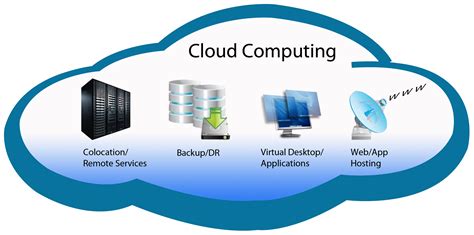
What is Cloud Infrastructure?
Have you ever wondered about the technology behind the seamless experience of cloud computing? Look no further, as we delve into the world of cloud infrastructure. Imagine a vast network of virtualized computing resources, accessible to users over the internet. This is essentially what cloud infrastructure is all about – the underlying foundation that empowers the wonders of cloud computing. It provides the necessary technology and resources for users to access and utilize virtualized computing power in a convenient and scalable manner.
Cloud infrastructure comprises a collection of servers, storage devices, networking components, and software applications that work together to deliver computing resources over the internet. These resources are seamlessly available to users on-demand, allowing them to quickly scale their operations, adapt to changing needs, and increase efficiency without the hassle of maintaining physical infrastructure.
One example of cloud infrastructure is the widely popular Amazon Web Services (AWS). AWS offers a range of services such as computing power, storage, and databases, all hosted on their extensive network of servers spread across geographic regions. By utilizing the AWS cloud infrastructure, businesses can access these services as needed, without the need to invest heavily in physical servers or worry about capacity limitations.
Cloud infrastructure also provides users with virtualization capabilities, enabling the creation of virtual machines and virtual networks. These virtual resources can be customized to suit specific needs and set up in a matter of minutes. Virtualization allows for the efficient utilization of hardware resources, as multiple virtual machines can be hosted on a single physical server. This leads to cost savings and improved efficiency, as the resources are shared among multiple users.
When it comes to security, cloud infrastructure offers robust measures to protect users’ data and applications. Cloud providers invest heavily in security protocols, firewalls, and encryption techniques to ensure data integrity and protect against unauthorized access. In addition, regular backups and disaster recovery plans are implemented to minimize data loss and ensure business continuity.
Cloud infrastructure is not limited to just big businesses. It also caters to the needs of small and medium-sized enterprises (SMEs), enabling them to compete in the rapidly evolving digital landscape. SMEs can leverage cloud infrastructure to access sophisticated tools and technologies that were once only available to larger organizations. This levels the playing field and opens up new opportunities for growth and innovation.
In conclusion, cloud infrastructure forms the backbone of cloud computing, providing users with the necessary technology and resources to access and utilize virtualized computing power over the internet. It offers scalability, flexibility, cost savings, and security, making it an essential component in today’s digital landscape. Whether you are a large enterprise or a small business, cloud infrastructure is the key to unlocking the full potential of cloud computing.
If you are interested in learning about different cloud solutions, check out this informative article on cloud solutions. It discusses various options available in the market.
The Components of Cloud Infrastructure
Cloud infrastructure encompasses a diverse range of components that work in harmony to deliver efficient and scalable cloud computing services. These components include servers, storage devices, networks, virtualization software, and security measures. Imagine a well-oiled machine where each part performs its unique function, working seamlessly together to create a powerful and reliable cloud infrastructure.
At the heart of cloud infrastructure are servers, acting as the foundation upon which everything else operates. Think of servers as the powerhouses that handle the processing and storage of data. They provide the computational power required to run applications, store files, and perform other essential tasks. Without servers, the entire cloud infrastructure would cease to function.
Working hand-in-hand with servers are storage devices, where data is stored and accessed. These devices range from hard disk drives (HDDs) to solid-state drives (SSDs) and utilize various technologies to ensure data reliability, speed, and accessibility. Storage devices play a crucial role in ensuring that data is readily available whenever it is needed, enabling users to access their files and applications seamlessly.
As the foundation of cloud infrastructure, servers and storage devices rely on networks to connect and communicate with each other. Networks facilitate the transfer of information between servers, storage devices, and end-users, ensuring a smooth flow of data. They allow individuals and organizations to access cloud-based services from anywhere in the world, making it truly convenient and accessible.
Virtualization software serves as a vital component in cloud infrastructure, enabling efficient resource allocation and utilization. Through virtualization, physical servers can be divided into multiple virtual servers, each capable of running different operating systems and applications. This capability allows for better resource management, scalability, and flexibility within the cloud infrastructure.
No discussion on cloud infrastructure would be complete without addressing the importance of security measures. As cloud computing continues to gain prominence, ensuring the security and integrity of data becomes paramount. Various security measures, such as firewalls, encryption, and access control, are implemented to safeguard against unauthorized access, data breaches, and other potential threats.
The components of cloud infrastructure are like puzzle pieces fitting together to create a comprehensive and robust system. The servers, storage devices, networks, virtualization software, and security measures work in perfect harmony, ensuring that cloud computing services are efficient, reliable, and scalable. The infrastructure is designed to handle a multitude of tasks, from hosting websites and running applications to storing and analyzing vast amounts of data.
So, the next time you log into your cloud-based applications or retrieve files from the cloud, take a moment to appreciate the intricate components that make it all possible. Behind the scenes, an impressive cloud infrastructure is working tirelessly, providing you with the convenience, accessibility, and reliability you rely on in this digital age.
Cloud services are an essential part of cloud infrastructure. Discover more about it in this detailed article on cloud services.
Benefits of Cloud Infrastructure
Cloud infrastructure, including our cutting-edge solution, offers a wide range of advantages that revolutionize how businesses operate in the digital age. This article will explore the numerous benefits of adopting cloud infrastructure, including increased flexibility, cost savings, scalability, improved disaster recovery capabilities, and enhanced accessibility for users.
When it comes to flexibility, cloud infrastructure reigns supreme over traditional on-premises systems. With our cloud solution, businesses can easily adapt to changing demands and evolving market trends. The cloud allows for seamless scalability, enabling companies to effortlessly adjust their resources based on their requirements. This agility ensures that organizations can respond promptly to customer needs, enhancing customer satisfaction and ultimately driving growth.
One of the most significant advantages of cloud infrastructure is the potential for cost savings. By leveraging the cloud, businesses can eliminate the need for upfront investments in expensive hardware and infrastructure. Instead, they can pay for the resources and services they consume, making it a more affordable option, especially for small and medium-sized enterprises. Additionally, cloud infrastructure reduces the need for dedicated IT staff to manage and maintain hardware, further lowering operational costs.
Scalability is key in today’s fast-paced digital landscape, and cloud infrastructure excels in this area. With just a few clicks, businesses can easily scale up or down their resources, ensuring they only pay for what they need. This eliminates the risk of overprovisioning or underutilization, allowing organizations to optimize their costs and resources efficiently.
Disaster recovery is a critical aspect of any business continuity plan, and cloud infrastructure offers improved disaster recovery capabilities. With traditional systems, data loss and system failures can have devastating consequences. However, with the cloud, data is stored and backed up remotely, providing an added layer of protection. In the event of a disaster, businesses can swiftly recover their data and systems, minimizing downtime and ensuring uninterrupted operations.
Furthermore, cloud infrastructure enhances accessibility for users, enabling them to access their data and applications from anywhere, at any time. This level of flexibility is particularly valuable in today’s remote work environment. Whether employees are working from home, on the go, or collaborating with colleagues from different locations, the cloud ensures that they can seamlessly access the resources they need, fostering productivity and efficiency.
In conclusion, cloud infrastructure offers a host of benefits that modern businesses cannot afford to overlook. From increased flexibility and cost savings to scalability, improved disaster recovery capabilities, and enhanced accessibility, the cloud revolutionizes the way organizations operate. By embracing cloud infrastructure, businesses can future-proof their operations, stay competitive, and focus on what truly matters – delivering exceptional products and services to their customers.
Cloud infrastructure serves as the backbone for cloud-based systems. Dive into the technical aspects with this comprehensive article on cloud infrastructure.
Cloud Infrastructure Providers
In today’s digital age, businesses rely on cloud infrastructure to store, process, and manage their data. One of the key players in this field is Amazon Web Services (AWS). AWS offers a comprehensive suite of cloud services and features that cater to various business needs. With its vast array of tools and a strong global presence, AWS has become a go-to solution for businesses of all sizes.
Another major player in the cloud infrastructure market is Microsoft Azure. With its robust offering of cloud computing services, Azure provides businesses with the scalability and flexibility they require. From virtual machines to Artificial Intelligence (AI) tools, Azure enables businesses to innovate and transform their operations in the cloud.
The third key player in the field is Google Cloud Platform (GCP). GCP offers a wide range of cloud-based services, including computing, storage, and data analytics. With its reliable infrastructure and cutting-edge technologies, GCP empowers businesses to run their applications efficiently and securely in the cloud.
Lastly, we have IBM Cloud, which completes the quartet of leading cloud infrastructure providers. IBM Cloud offers businesses a combination of infrastructure, platform, and software services. From deploying complex applications to managing data, IBM Cloud provides businesses with the tools they need to drive innovation and achieve their goals in the digital realm.
These cloud infrastructure providers have revolutionized the way businesses operate. They offer scalable solutions that can adapt to the ever-changing needs of businesses. Whether it’s storing and processing data, running applications, or leveraging advanced technologies like AI and machine learning, these providers have it all.
When choosing a cloud infrastructure provider, businesses should consider their specific requirements and goals. Each provider offers a unique set of services and features, and it’s essential to evaluate which aligns best with their needs. Factors such as cost, scalability, security, and geographical coverage should be taken into account.
Furthermore, it’s important to note that these providers offer more than just infrastructure services. They also provide a wide range of add-ons and tools that enhance the cloud experience and enable businesses to leverage the full potential of the cloud. From databases and analytics to Internet of Things (IoT) platforms, these providers offer a comprehensive ecosystem of services.
In conclusion, cloud infrastructure providers such as Amazon Web Services, Microsoft Azure, Google Cloud Platform, and IBM Cloud are at the forefront of the cloud computing revolution. They offer a wide array of services and features that enable businesses to scale, innovate, and transform in the digital age. With their robust infrastructures and cutting-edge technologies, these providers are shaping the future of business operations. So, when considering a move to the cloud, businesses cannot ignore the offerings of these leading providers.
Cloud technology is constantly evolving. Stay updated on the latest advancements by reading this article on cloud technology.
Future Trends in Cloud Infrastructure
The future of cloud infrastructure is incredibly promising, as technological advancements continue to shape the way businesses operate and store their data. As companies strive for more efficient and eco-friendly solutions, several key trends are emerging in the field of cloud infrastructure. These trends include edge computing, serverless architecture, artificial intelligence integration, and a greater emphasis on green and sustainable practices.
One of the most exciting developments in cloud infrastructure is the rise of edge computing. This approach brings data processing closer to the source, reducing latency and improving overall performance. Instead of relying solely on a centralized cloud server, edge computing allows for distributed computing resources at the edge of the network. This is particularly useful in scenarios that require real-time data analysis, such as autonomous vehicles, IoT devices, and remote monitoring systems. By bringing the computing power closer to the data source, edge computing enables faster decision-making and reduces the strain on the core cloud infrastructure.
Another trend shaping the future of cloud infrastructure is the growing adoption of serverless architecture. Serverless computing allows developers to write and execute code without the need to manage servers or infrastructure. Instead, cloud providers handle all the backend operations, automatically scaling the resources as needed. This approach offers several advantages, such as reduced operational costs, increased development speed, and improved scalability. With serverless architecture, businesses can focus more on their core functionalities and innovation, rather than infrastructure management.
Artificial intelligence (AI) integration is another significant trend in cloud infrastructure. As AI technologies continue to advance, integrating them with cloud infrastructure enables businesses to harness the power of AI for data analysis, predictive modeling, and automation. With AI-driven analytics, organizations can gain valuable insights from their vast amounts of data, make informed decisions, and optimize their operations. AI integration in cloud infrastructure also enables intelligent automation, improving efficiency and streamlining processes. It empowers businesses to automate repetitive tasks, freeing up valuable human resources for more complex and strategic initiatives.
Furthermore, the future of cloud infrastructure is also characterized by a greater focus on green and sustainable practices. As the demand for cloud services grows, so does the energy consumption of data centers. To mitigate the environmental impact, cloud providers are investing in renewable energy sources, energy-efficient hardware, and innovative cooling technologies. Additionally, data centers are adopting techniques like virtualization and consolidation to optimize resource utilization and reduce overall energy consumption. By adopting greener practices, cloud infrastructure can support a more sustainable and eco-friendly computing environment.
In conclusion, the future of cloud infrastructure is bright and filled with potential. Edge computing, serverless architecture, AI integration, and green practices are just a few of the emerging trends that will shape the cloud infrastructure landscape. These advancements aim to provide businesses with more efficient, flexible, and environmentally conscious solutions. As technology continues to evolve, it is crucial for organizations to stay informed and adapt to these trends to thrive in the increasingly competitive digital world.
A great resource for understanding cloud computing is the article on cloud computing. It provides in-depth information about the basics and benefits of cloud computing.
 Cloud Solution All Cloud Information
Cloud Solution All Cloud Information








